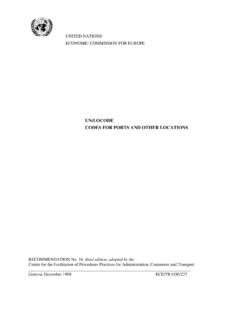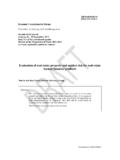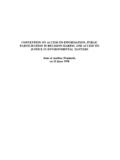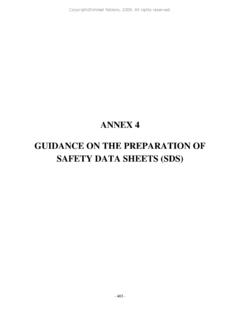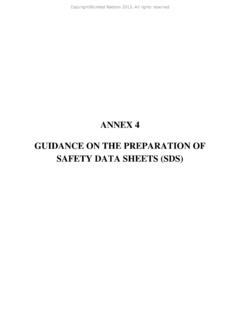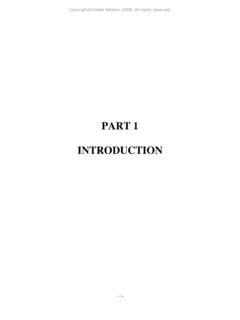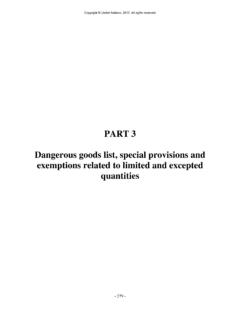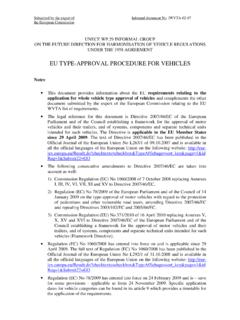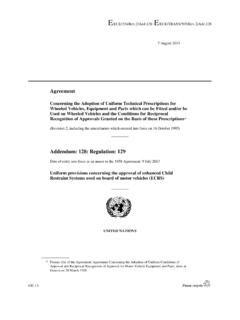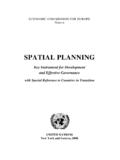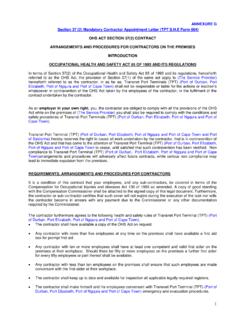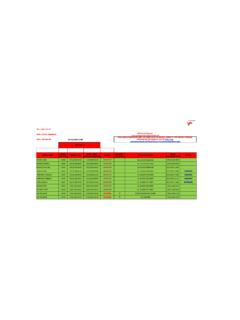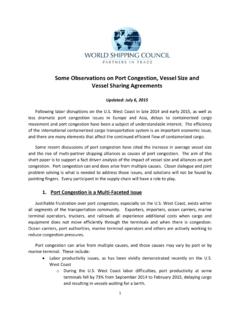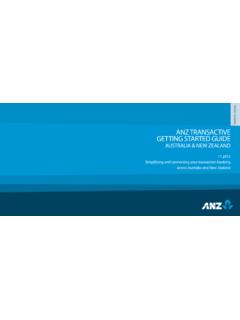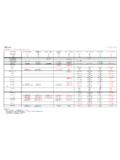Transcription of European Agreement - UNECE
1 ECE/ trans /225 ( )Volume I applicable as from 1 January 2013 Economic Commission for Europe Committee on Inland TransportUNITED NATIONS New York and Geneva, 2012 European Agreement Concerning the International Carriage of Dangerous Goods by Road Copyright United Nations, 2012. All rights reserved NOTE The designations employed and the presentation of the material in this publication do not imply the expression of any opinion whatsoever on the part of the Secretariat of the United Nations concerning the legal status of any country, territory, city or area, or of its authorities, or concerning the delimitation of its frontiers or boundaries. ECE/ trans /225 ( ) Copyright United Nations, 2012 All rights reserved.
2 No part of this publication may, for sales purposes, be reproduced, stored in a retrieval system or transmitted in any form or by any means, electronic, electrostatic, magnetic tape, mechanical, photocopying or otherwise, without prior permission in writing from the United Nations. UNITED NATIONS PUBLICATION Sales No.: ISBN 978-92-1-139143-5 (complete set of 2 volumes)e-ISBN 978-92-1-055476-3 Volumes I and II not to be sold separately. Copyright United Nations, 2012. All rights reserved - iii - United Nations Economic Commission for Europe ( UNECE ) The United Nations Economic Commission for Europe ( UNECE ) is one of the five United Nations regional commissions, administered by the Economic and Social Council (ECOSOC).
3 It was established in 1947 with the mandate to help rebuild post-war Europe, develop economic activity and strengthen economic relations among European countries, and between Europe and the rest of the world. During the Cold War, UNECE served as a unique forum for economic dialogue and cooperation between East and West. Despite the complexity of this period, significant achievements were made, with consensus reached on numerous harmonization and standardization agreements. In the post-Cold War era, UNECE acquired not only many new member States, but also new functions. Since the early 1990s the organization has focused on analyses of the transition process, using its harmonization experience to facilitate the integration of central and eastern European countries into global markets.
4 UNECE is the forum where the countries of western, central and eastern Europe, Central Asia and North America 56 countries in all come together to forge the tools of their economic cooperation. That cooperation concerns economics, statistics, environment, transport , trade, sustainable energy, timber and habitat. The Commission offers a regional framework for the elaboration and harmonization of conventions, norms and standards. The Commission's experts provide technical assistance to the countries of South-East Europe and the Commonwealth of Independent States. This assistance takes the form of advisory services, training seminars and workshops where countries can share their experiences and best practices.
5 Copyright United Nations, 2012. All rights reserved - iv - transport in UNECE The UNECE Inland transport Committee (ITC) facilitates the international movement of persons and goods by inland transport modes. It aims to improve competitiveness, safety, energy efficiency and security in the transport sector. At the same time it focuses on reducing the adverse effects of transport activities on the environment and contributing effectively to sustainable development. The ITC is a: - Centre for multilateral transport standards and agreements in Europe and beyond, regulations for dangerous goods transport and road vehicle construction at the global level - Gateway for technical assistance and exchange of best practices - Promoter of multi-country investment planning - Substantive partner for transport and trade facilitation initiatives - Historic centre for transport statistics.
6 For more than six decades, ITC has provided a platform for intergovernmental cooperation to facilitate and develop international transport while improving its safety and environmental performance. The main results of this persevering and important work are reflected in more than 50 international agreements and conventions which provide an international legal framework and technical regulations for the development of international road, rail, inland water and intermodal transport , as well as dangerous goods transport and vehicle construction. Considering the needs of the transport sector and its regulators, UNECE offers a balanced approach to and treatment of facilitation and security issues alike.
7 Copyright United Nations, 2012. All rights reserved - v - FOREWORD General The European Agreement concerning the International Carriage of Dangerous Goods by Road (ADR) was done at Geneva on 30 September 1957 under the auspices of the United Nations Economic Commission for Europe, and it entered into force on 29 January 1968. The Agreement itself was amended by the Protocol amending article 14 (3) done at New York on 21 August 1975, which entered into force on 19 April 1985. According to article 2 of the Agreement , dangerous goods barred from carriage by Annex A shall not be accepted for international transport , while international transport of other dangerous goods shall be authorized subject to compliance with: - the conditions laid down in Annex A for the goods in question, in particular as regards their packaging and labelling; and - the conditions laid down in Annex B, in particular as regards the construction, equipment and operation of the vehicle carrying the goods in question.
8 Nevertheless, according to article 4, each Contracting Party shall retain the right to regulate or prohibit, for reasons other than safety during carriage, the entry of dangerous goods into its territory. Contracting Parties also retain the right to arrange, by bilateral or multilateral agreements, that certain dangerous goods which are prohibited from carriage by Annex A be internationally carried, subject to certain conditions, on their territories, or that dangerous goods authorized to be carried internationally according to Annex A be carried on their territories under conditions less stringent than those specified in Annexes A and B. Annexes A and B have been regularly amended and updated since the entry into force of ADR.
9 Structure of Annexes A and B The Working Party on the transport of Dangerous Goods ( ) of the Economic Commission for Europe s Committee on Inland transport decided, at its fifty-first session (26-30 October 1992), to restructure Annexes A and B, on the basis of a proposal by the International Road transport Union ( , paras. 100-108). The main objectives were to make the requirements more accessible and more user-friendly so that they could be applied more easily not only to international road transport operations under ADR, but also to domestic traffic in all European States through national or European Community legislation, and ultimately to ensure a consistent regulatory framework at European level.
10 It was also considered necessary to identify more clearly the duties of the various participants in the transport chain, to group more systematically the requirements concerning these various participants, and to differentiate the legal requirements of ADR from the European or international standards that could be applied to meet such requirements. The structure is consistent with that of the United Nations Recommendations on the transport of Dangerous Goods, Model Regulations, the International Maritime Dangerous Goods Code (IMDG Code) and the Regulations concerning the International Carriage of Dangerous Goods by Rail (RID). It has been split into nine parts, but still grouped under two annexes to align with the wording of article 2 of the Agreement itself.
